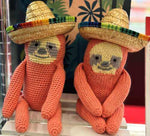*** Free UK delivery on orders over £75 ***
Menu
-
- New
-
Yarn
- Stitching
-
Hooks & Needles
-
Accessories
-
All Accessories
- Blocking
- Books and Magazines
- Buttons
- Cable Needles
- Chart Keepers
- Darning Needles and Pins
- Needle and Hook Cases
- Notebooks and Stationery
- Pom Poms
- Row Counters
- Rulers and Needle Gauges
- Scissors
- Sewing
- Stitch Holding Cords
- Stitch Markers
- Stitch Stoppers
- Swifts and Winders
- Wool Wash
- Yarn Bowls
- Yarn Snugs
- Other
- Bags
- Brands
-
All Accessories
-
Patterns & Kits
-
Gifts
- Sale
-
How to & Ideas
-
- Login

*** Free UK delivery on orders over £75 ***
Choosing Yarn Substitutes
October 07, 2022 5 min read

Can't find the exact yarn that your pattern recommends? Don't worry! Using good yarn alternatives will still give you successful results. Our guide to yarn substitution helps you figure out what to use for your next knitting project.
Contents
- Why Substitute Yarn?
- Substituting Yarn of a Different Weight
- Substituting a Yarn with a Lighter Weight
- Substituting a Yarn with a Heavier Weight
- Substituting Multiple Strands of Yarn
- Substituting Yarn with a Different Fibre Content
Why Substitute Yarn?
New knitters often feel the need to buy the exact yarn that a pattern recommends - but as you get more experienced, you'll realise that there are many reasons why you might seek out yarn substitutes instead. Sometimes it could be for a simple, practical reason: the pattern recommends a yarn that is only available in certain countries, has been discontinued, or is just too expensive. Other times a knitter might want to choose a yarn substitute because of allergies, ethical concerns (such as veganism), or just personal preferences. Some knitters find they can't match the pattern's gauge and have to choose a heavier or lighter yarn instead.
The question of how to substitute yarn can be confusing at first. There are a number of things to consider. From a practical, knitting point of view, start by thinking about weight. The most common yarn substitutions involve replacing one yarn for another of the same weight - for example, if the pattern calls for a DK yarn, substituting it with another DK yarn. Choosing a heavier yarn, such as Aran, or a lighter one, such as sport, will change the tension of your knitting, and could result in a piece that doesn't fit well.
Substituting Yarn Step by Step
If you want your yarn substitution to be close to the pattern's yarn, you'll need to pay attention to weight and fibre. Luckily, this information is all easily available on Ravelry. Here you'll find an overview of pretty much every yarn on the market today. This can help you create your own yarn substitution chart for UK knitters.
- Take a look at the yarn suggested by the pattern, and make a note of the fibre content and the weight. These are the two most important pieces of information to know when you make your substitution.
- Look at the number of metres the yarn has in a ball. Generally, yarns of the same weight will have more or less the same number of metres per gram, but they can vary a little. If you're looking at an American pattern, be sure to check whether it refers to metres or yards.
- Take a look at the pattern's gauge, the number of stitches per cm/inch.
- Now you can use Ravelry's Advanced Search function to find a suitable yarn. This is a powerful tool that lets you filter by fibre, weight, suggested needle size, and more. You can even try filters for superwash treatments, hand-dyed yarns, and other criteria.
- Most patterns will tell you how many balls of yarn you need for each size - for example, a size small might require 4, and a medium 5. If there are 100m of yarn in each 50g ball of the pattern's yarn, and you want to knit a size medium, you'll know that you need approximately 500m. Maybe the yarn you want to use comes in balls of 100g, rather than 50g, so always pay attention to the number of metres.
- Now you can browse Yarn Worx to find your yarn substitute, and you're ready to start knitting!
Yarn Conversion Chart
This yarn weight chart can be a useful starting place if you need to substitute yarn from a pattern from a different country, such as the US, but want to keep the same weight as the yarn recommended in the pattern.

Substituting Yarn of a Different Weight
Substituting yarn weights is a little more complicated, and may involve some trial and error to get the desired result. Some knitters substitute yarns of a different weight to change the size of their finished item.
It's far easier to substitute a different yarn weight if you're making something like a scarf or a shawl, where the finished measurements aren't so important. Making something that has to fit - a jumper, hat, or socks, for example - is more difficult.
Substituting a Yarn with a Lighter Weight
Substituting a lighter weight of yarn without changing the needle size will create a looser fabric. The holes in the stitches will be larger, and the fabric will drape more. Take a scarf pattern, for example: knit in a thick yarn, it will be cosy and suitable for winter. The same pattern in a lighter yarn will be airy and drapey, and may be better for milder weather.
If you want to use a lighter weight of yarn to knit a smaller version of the pattern, you'll also need to change knitting needle or crochet hook size. Be sure to make a gauge swatch before you start. You will need more metres of yarn when working with a lighter weight. Take a look at our yarn requirement guide to give you an idea.
Substituting a Yarn with a Heavier Weight
Substituting a yarn with a heavier weight will create a thicker, denser fabric. It will feel more solid, and won't have as much drape.
You can use a heavier yarn and bigger needles to make a larger size version of the pattern. Just like if you're substituting a lighter weight yarn, it's essential to make a gauge swatch before you start.
Substituting Multiple Strands of Yarn
It's possible to substitute multiple strands of finer yarn for a single strand of a heavier yarn. For example, holding two strands of 4-ply yarn will give you the same weight as DK. You can find more information by looking at a yarn weight substitution chart. Some knitters use multiple strands so they can create unique effects with variegated colours of yarn. It's also an interesting way to play with different fibres. For example, holding a strand of mohair with merino gives you mohair's trademark fuzzy halo, along with the strength and softness of merino.
Alternatively, you might have a pattern that calls for multiple strands of yarn, and you'd prefer to use a single strand. Either way, be sure to start with a gauge swatch so you can get a good idea of what your project will look and feel like.
Substituting Yarn with a Different Fibre Content
There are many reasons why knitters choose to substitute a different fibre: allergies, ethical concerns like veganism, ease of washing, and more. You might also want to create a different look for your piece, or to make it warmer or cooler.
Think carefully when choosing a new type of yarn. For example, cotton has a beautiful drape, but does not hold its shape well, and stretches easily, so it may not work as a wool substitute. Some yarns, such as mohair and alpaca, have a distinctive halo effect, which will be lost if substituted. This will affect the appearance of your finished piece. Most sock yarn is a superwash blend of wool or merino and nylon; if replaced with pure wool, it is likely to felt or tear at the heels and toes.
In general, animal fibres are grippier than plant fibres or synthetic fibres. Only animal fibres can be felted, and techniques such as steeking - which require the fibres to cling to each other - are very difficult with plant-based or synthetic yarns.
Summary
Substituting yarn can be tricky at first. If you're just starting out, only substitute one similar yarn for another, until you're more confident in your choices. Check out the extensive Yarn Worx range and you'll always find the right yarn for the job!
Related articles
What is worsted weight yarn?
What is merino wool?
What is sock yarn?
Also in Yarn Guides

What is boucle yarn?
March 21, 2025 2 min read
Boucle yarn is a popular material for knitting that creates a unique textured fabric. Learn everything you need to know about boucle with our in depth guide!

How to crochet a magic circle
May 19, 2023 4 min read

5% off your first order when you join our email newsletter...
Be the first to know of new product releases and other exciting news! A discount code will be sent to your email straight away!

